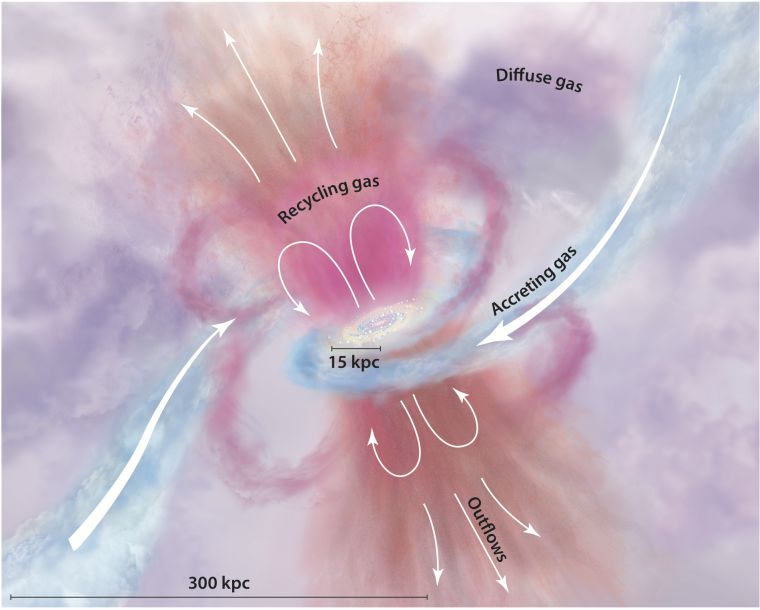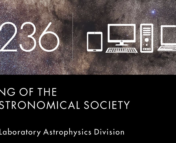Title: Testing galaxy feedback models with the first resolved profiles of the circumgalactic medium
Authors: Urmila Chadayammuri, Akos Bogdan, Benjamin Oppenheimer, Ralph Kraft, William Forman, Christine Jones
First Author’s Institution: Center for Astrophysics | Harvard & Smithsonian, 60 Garden St, Cambridge, MA – 02138, USA
Status: Submitted to AAS Journals [open access on arXiv]
The circumgalactic medium (or CGM) – the extensive reservoir of gas enclosing each galaxy – is notoriously difficult to detect. Since the CGM appears to be at the center of a wide array of unsolved problems in galaxy evolution, this sparsity of data is detrimental. In lieu of observations, then, many have turned to computer simulations for insight into this circumgalactic mystery. But, while these simulation-based models may be motivated by theory, it remains to be seen whether they agree with actual data. That’s where today’s authors come in.
For the first time, astronomers have produced detailed maps of the hot, diffuse gas of the CGM. With the real CGM in view, it’s time to put those simulation-based models to the test.

The CGM values your (galactic) feedback
The dynamics of the CGM are complicated – and still not fully understood. As illustrated in Figure 1, as the CGM pulls in material from the filaments of the cosmic web, outflows from the galactic disc – driven by a slew of processes known collectively as galactic feedback – act to recycle, stir up, and expel CGM gas. These feedback mechanisms are the chief regulators of galactic star formation, controlling how much gas from the CGM can fall into the disc and collapse into stars. In some cases, feedback can even shut down star formation altogether.
Galactic feedback comes in many flavors. In younger galaxies with vibrant star formation, supernova explosions, winds from massive stars, radiation from newborn stars, and other small-scale stellar processes can act in concert to pressurize gas in the galactic disc, in turn launching energetic streams of matter into the CGM. In older galaxies, where star formation occurs less readily, feedback is dominated by the ejecta of active galactic nuclei, massive black holes that emit powerful jets as they suck in their surroundings. Each feedback process leaves its unique mark on the diffuse CGM, which is retained throughout cosmic time.
Any theoretical model of the CGM must reproduce the signatures imprinted by feedback. For huge simulations of galaxy evolution, like IllustrisTNG and EAGLE, accurately representing feedback is a significant challenge. Since the processes that drive galactic feedback originate at small scales relative to the full galaxy, most big simulations can’t zoom in far enough to fully capture these phenomena; instead, the models rely on feedback “prescriptions,” or ad hoc equations that attempt to emulate the effects of feedback on larger scales. Today’s authors seek to provide some feedback on these feedback prescriptions.
Writing the rubric

To assemble a picture of the hot CGM and capture galactic feedback on camera, the authors combine 2643 X-ray images of galaxies observed by the eROSITA telescope. In a technique known as stacking, the authors average out the data across each of these images, amplifying the signal from the CGM while filtering out the background noise. Since these eROSITA galaxies span a factor of ten in stellar mass, the authors divide the stack into low-mass (masses between 16 billion and 50 billion solar masses) and high-mass (masses between 50 billion and 160 billion solar masses) substacks. By cross-checking with other data sets, the authors further subdivide these stacks into star-forming and quiescent (or non-star-forming) classes.
After removing contaminant sources like background galaxy clusters and the interstellar medium, the authors produce maps of the surface brightness (or the perceived brightness per area) of the resolved CGM, as shown in Figure 2. Remarkably, X-ray emission from the CGM is clearly visible in all four stacks, with the emission being brighter and more extended in the higher-mass group.
The authors spot a few trends in the surface brightness and X-ray luminosity (or the intrinsic brightness of X-ray emission) of the stacked galaxies. While the luminosities are similar between the star-forming and quiescent stacks, the CGM of the star-forming galaxies is slightly brighter. More striking, however, is the fact that the luminosities of the star-forming galaxies are largely independent of galaxy mass, while the luminosities of the quiescent galaxies increase with increasing mass. With regard to surface brightness, Figure 3 shows that the surface brightnesses of star-forming galaxies vary less with distance from the galactic center than do those of quiescent galaxies, especially at low masses. Moreover, the anomalously high surface brightness in the 40-100 kpc range for the low-mass star-forming galaxies is particularly interesting.
So, given these trends, how do simulations stack up against the eROSITA stacks?

Constructive computational criticism
Comparing profiles of the CGM generated by the IllustrisTNG and EAGLE simulations to the observational data collected by eROSITA reveals some glaring inconsistencies. While both the simulations and the observations show weaker X-ray emission in quiescent galaxies than in star-forming galaxies – suggesting that AGN feedback is more effective than stellar feedback at expelling gas from the CGM – the low-mass eROSITA galaxies are up to ten times brighter than those generated in simulations (see the left panels of Figure 3). This suggests that these simulations rely too heavily on ejecting the CGM as a mode of shutting down star formation, and thus the AGN feedback prescriptions need to be dialed back.
In the star-forming galaxies, both simulations show a much stronger trend between luminosity and galaxy mass than is shown in the eROSITA data; this might mean that stellar feedback is more powerful than previously thought, efficiently clearing out the inner CGM (as opposed to merely recycling gas near the galactic disc) and pushing the X-ray emitting gas to larger radii.
Evidently, our simulated feedback prescriptions need some work. Fortunately, as more of the CGM comes into view with more sophisticated observational missions – like the eRASS survey, which promises to image the X-ray sky with 300 times the coverage as the data used in today’s paper – our models can only improve. Together, the influx of observational and simulation-based data will drive a positive feedback loop, launching us into a new era of galactic astronomy.
Astrobite edited by: Mark Popinchalk
Featured image credit: istockphoto.com and Tumlinson et al. (2017)




